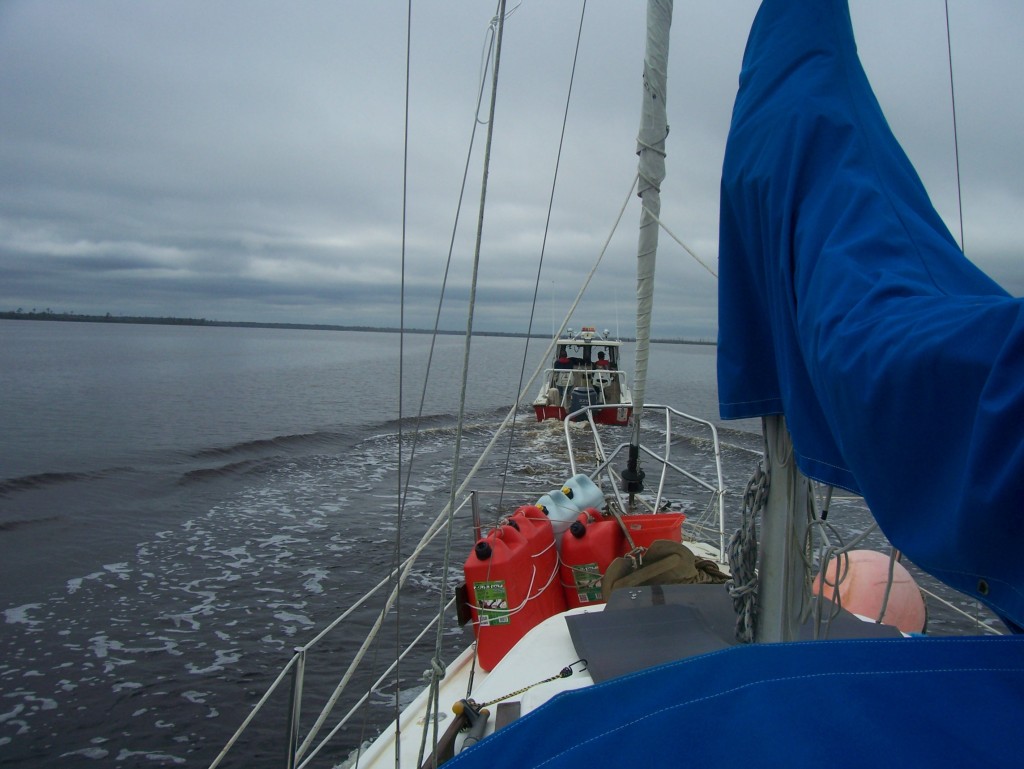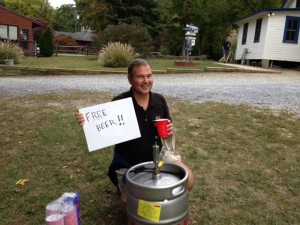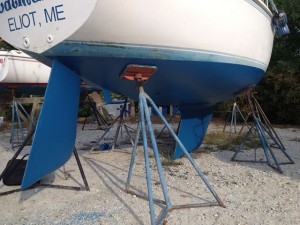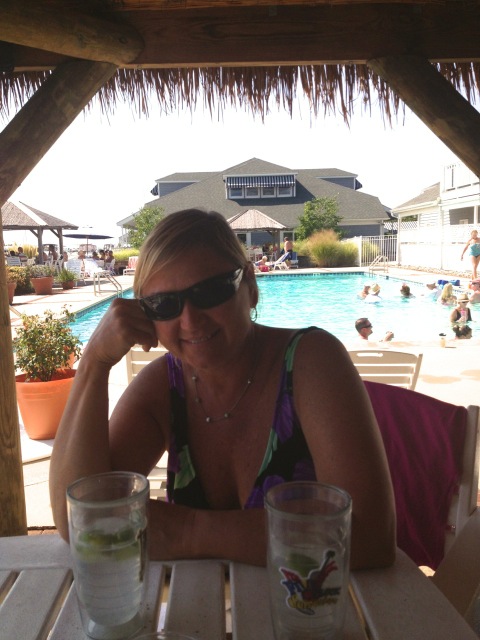With Catmandu running perfectly, we leave Belhaven and the good people at Dowry Creek Marina. Last night, we celebrated Catmandu’s repair with our friend, Jean-Luc, and a bottle of Plantation Rum. We finished the rum, had dinner and wine with Jean-Luc, and came back to Catmandu very, very happy. So happy, we decided to do this “selfie” photo. Okay, it may not have been our wisest decision.
We cast off our lines early in the morning and head out into the Pungo River and then into the Pamlico River. Here the water opens up and there is enough wind to sail. The sun hasn’t been out for days, but the wind is good and it’s not raining. I am amazed by the huge expanses of water in the State of North Carolina. We are seeing a different view of this state, and it is not the I-95 view. It is natural, wild, and undeveloped.
Our friends on Cinderella had left Belhaven ahead of us to make a boat repair appointment in Oriental. They texted one word along the way: “Dolphins!” Motor-sailing through the Pamlico River, my eyes are on the water, looking for those dorsal fins and puffs of water vapor that herald these marine mammals with the cheerful smiles. As we make our way into Goose Creek, the boat traffic picks up and we pass tugboats, barges, and fishing vessels. The Hobucken Coast Guard station, midway down the creek, is a tiny station with one small boat, surrounded by huge commercial vessels.
We had heard calls on the radio last night from Hobucken Coast Guard for a lost vessel called Blue Moon II. The sailing vessel had reported being lost, and the Coast Guard was asking for help in finding her. I can’t imagine how anyone could get lost with all of the markers in the waterways, canals and rivers. Still, I feel sad for these navigators who have lost their way.
After Goose Creek, we entered Bay River, the exact area where Jaye on Cinderella had seen dolphins. I spend the afternoon scanning the gray water for dorsal fins, but they aren’t there. It’s a little disappointing, but it is a nice day and we are putting miles behind us. Late in the afternoon, the sun almost comes out.
Bay River flows into the Neuse River, but don’t picture narrow winding channels. Both of these waterways are huge, with distant shores and plenty of deep water. So, we are surprised when we spot a sailboat coming across our path. Phil says, “They will pass behind us,” but they keep on coming. To be safe, Phil changes course slightly. The vessel makes a sudden sharp turn to starboard, again on a collision course with us. It suddenly turns again and passes closely behind us. Then we notice the name: It’s Blue Moon II. I think it must be captained by ghosts. Or zombies.
We pull into Oriental, NC for the night. There is a restaurant at the marina, a tiki bar and a pool. Paradise! Our friends Dan and Jaye join us at the tiki bar after dinner, and the first thing they ask is, “Did you see dolphins?” In spite of the fact that we looked all day, no, there were no dolphins. We get a better description of what she saw: a pair of jumping, spinning healthy-looking mammals, putting on a Sea World show. I’m a little jealous.

Kay and Phil, at a little coffee shop called “The Bean,” in Oriental, the sailing capital of North Carolina.
The sun has been very rare on this trip so far. Jaye tells us that the cloudy skies and drizzle have caused the locals to call this the NENE, Never Ending Nor-Easter. But the morning sun is bright and we are anxious to leave on this beautiful morning. We are headed to Morehead City, just 20 miles away. It will be a good chance to rest, provision, and maybe have some pizza.

Our friends and mentors, Dan and Jaye Lunsford, saying goodbye in Oriental. They get around on these handy scooters, compact enough to carry on Cinderella.
We head out of Oriental and soon enter the Adams Creek canal. As we come out of the canal and into the Newport River, Phil spots fins. “Dolphins! Look!” he says, and I can’t see them at first. Then, they are all around the boat, first four, then six, moving through the water. It is so unexpected, I don’t have the camera ready. I watch them go past, and one turns its head to me, right next to the boat. Phil has cut the engine so I could get pictures, but this is all I can get:
Phil marked the spot with the GPS, and used charting software to make this map. Here is where we saw our first dolphins:
I am sorry I have no photos to show. The camera, and the photographer, are not good enough to catch them as they rise in the waves and dive down again. Dolphins are quick, and they are the same color as the water. Their sleek backs curve up and down, synchronized with their mates. They seem to travel in pairs or pods, hardly ever alone. They are smaller than I imagined. One even coughed nearby and sent up a little plume of vapor. I saw the face of one, and the backs of many more.
It’s funny that they appear in an unlikely place, in fairly shallow water, at a time when my eyes are not scanning the waves for a glimpse of them.
Now, I think maybe dolphins are like love: You can only find them when you aren’t looking.






































